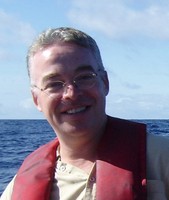The foundation of ATLAS is improving our understanding of ocean circulation in the Atlantic. Atlantic ocean currents not only connect deep-sea ecosystems, but move vast quantities of heat, salt, and energy across the Atlantic basin. As the Earth’s climate changes we need to understand how this affects the Atlantic Meridional Overturning Circulation (AMOC) and what implications this will have for ecosystem functioning, biodiversity, and genetic connectivity.
Led by Stuart Cunningham (SAMS) Work Package 1 is obtaining a deeper understanding of how ocean dynamics drive ecosystem response.
Key objectives
- Producing new biogeochemistry measurements integrated with circulation from the existing AMOC arrays and analysing palaeo-proxies of the last millennium to quantify physical links between ocean circulation, ecosystems and resources on multi-decadal to millennial timescales. During the annual OSNAP/EEL cruise in May 2017, the existing OSNAP Subpolar North Atlantic Array moorings in the Rockall Trough were instrumented with oxygen (O2), acidity (pH), and carbon dioxide (pCO2) sensors and a water sampler for nitrate, silicate and phosphate. For the first time, this will provide the co-variability of circulation and biogeochemical fluxes, on monthly to inter-annual timescales.
- Quantifying how ecosystems respond (their sensitivity and tipping points) to ocean properties and circulation. Environmentally-driven ecosystem tipping points are being assessed by focusing on local extinction events across the North Atlantic using the widely distributed Vulnerable Marine Ecosystems indicator of cold-water coral reef ecosystems.
- Understanding the potential for ecosystems and resources to be connected by ocean circulation pathways. Ocean transport pathways are being mapped using the state-of-the-art basin-scale eddy-resolving VIKING20 model with off-line water-mass and larval tracking methodologies (e.g. ARIANE and LTRANS). VIKING20 is being used to provide a realistic representation of the transport and mixing of ocean currents at all management scales and to generate initial and lateral boundary conditions for model development and scenarios in other work packages. Together, these approaches will provide detailed knowledge of the ocean and ecosystem variability now and over the past millennium, as well as the main drivers for ecosystem change and connectivity.
Meet the Team
 Lead: Professor Stuart Cunningham (SAMS)
Lead: Professor Stuart Cunningham (SAMS)
Stuart Cunningham is an observational Physical Oceanographer with a Bachelor in Astrophysics (University of Edinburgh), a Master in Physical Oceanography (University College of North Wales) and a PhD in Ocean Inverse Modelling (University of Liverpool). Stuart joined the Institute of Oceanographic Sciences in 1990 and then the National Oceanography Centre, Southampton. In August 2012 he joined SAMS as the MASTS appointment in Physical Oceanography. As an observational physical oceanographer, Stuart has participated in more than 32 research cruises (800+ days at sea) and he has written or co-authored +60 scientific publications including three in Nature or Science.
From 2004 to 2012 Stuart was Principal Investigator for the NERC/NSF funded RAPID-WATCH programme for sustained observations of the Atlantic Meridional Overturning Circulation at 26.5°N.
Over several years Stuart has been advocating and proposing basin-wide observations in the subpolar gyre because of the relevance to the UK. Stuart has been a leader or major partner in UK and EU programmes (Thermohaline Overturning at Risk? and North Atlantic Climate Variability); and in international programmes interacting with funding and coordination agencies (e.g. NSF, NOAA, CLIVAR, OceanObs and the UK MCCIP). He is a contributing author for the International Panel on Climate Change and provides national and international leadership through the adoption and exploitation of new technology and through the leadership of science programs and the promotion of large-scale
 Deputy: Dr David Thornalley (University College London)
Deputy: Dr David Thornalley (University College London)
David is a lecturer at the University College London with a Master (University of Cambridge) and PhD (University of Cambridge) degree. David joined University College London in 2013 as a Lecturer.
David’s research focuses on constraining how the circulation of the ocean changed in the past and the mechanisms by which these changes affected the global climate system and marine ecosystems. David his goal is understanding the causes, mechanisms and impacts of climate change on decadal to millennial timescales. He uses a range of sedimentary and geochemical proxies in marine sediment cores, with a particular emphasis on reconstructing past changes in the circulation of the North Atlantic. He uses a wide range of tools including: faunal assemblage, isotope and elemental ratio (e.g., Mg/Ca, B/Ca, Cd/Ca) analysis of foraminifera to reconstruct water mass properties; geochemical proxies of circulation such as measurement of Pa/Th ratios, Nd isotopes and radiocarbon concentrations; examination of the detrital components of sediment such as ice-rafted detritus and geochemical analysis of tephra for improving stratigraphy; sediment grain size analysis (e.g. sortable silt analysis) to reconstruct relative changes in paleo-current strength; and fluxes and composition of organic matter to the seafloor, combined with benthic faunal assemblage to investigate marine ecosystem changes.




